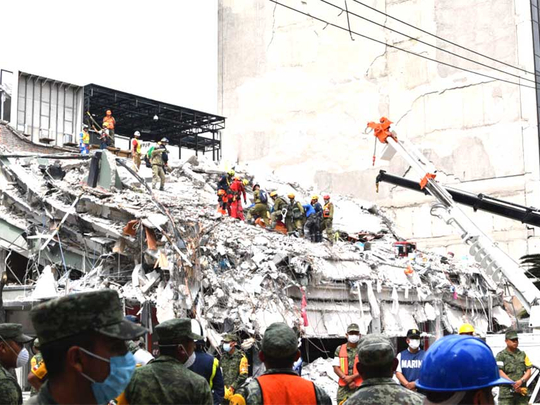
Early in the morning of September 19, 1985, a ferocious earthquake shook Mexico City. For almost two minutes, the wobbly metropolis trembled and jumped, jolted by a movement not felt since a 1957 tremor, which toppled the Angel de la Independencia, one of the city’s most renowned landmarks, from its 120-foot column. In 1985, the golden statue stood aloft, but the consequences of the earthquake were otherwise devastating: Hundreds of buildings had collapsed within seconds, including hotels, hospitals, theatres and scores of apartment complexes. Close to a million people were left homeless, living in makeshift camps, in some cases for years on end. More than 12,000 people died, according to some estimates.
Last Tuesday, exactly 32 years later, another violent earthquake struck the Mexican capital, a jerk of a tremor that whiplashed the city a few minutes before lunch. Forty buildings buckled, the harrowing scenes broadcast over the internet like a live version of an apocalyptic movie. By nightfall, Mexico’s government had confirmed more than 200 people dead, with many more buried in the rubble all over Mexico City (the city’s strict building codes prevented a worse outcome). The number of structures that have suffered severe fundamental damage could reach the hundreds. In southern Mexico City, the heartbreak became almost unbearable when authorities confirmed the collapse of the Enrique Rebsamen elementary school, where dozens of children have died and more are missing.
And yet, from within the cloud of unspeakable tragedy, a silver lining has glimmered through. Like in 1985, Mexican solidarity has lifted a country sunk in violence and acrimonious political and social discontent. Scores of volunteers spontaneously joined the authorities and first responders, including the Mexican armed forces, to dig through the rubble. People took to the streets to offer water and food, activists quickly established collection centres, and social media worked its virtuous magic, connecting possible volunteers with places where they were needed.
Mexico’s defiant camaraderie in the face of calamity is well-known around the world, not least in the United States. In 2005, in the aftermath of Katrina, the Mexican government sent a 45-vehicle army convoy with 200 men to help out. And help they did, serving 170,000 meals and distributing more than 180,000 tonnes of supplies to the needy in three weeks of work. Mexico again sent much-needed assistance after Harvey’s devastation of Houston last month, including emergency supplies and a large team of paramedics.
Unfortunately, a few hours into Mexico’s recent tragedy, solidarity has not been reciprocal. When a major earthquake hit Mexico, sinking Oaxaca and Chiapas, the country’s poorest regions, into grief and misery, it took US President Donald Trump one long week to reach out to Mexican President Enqrique Pena Nieto to offer the most basic of condolences. Last Tuesday, after the latest earthquake had shaken Mexico City, Trump found the time and energy to pick up his phone and write a short tweet, asking God to bless Mexico City. It wasn’t always like this. In 1985, the administration of president Ronald Reagan moved quickly to publicly express solidarity and fully support its southern neighbour. First lady Nancy Reagan travelled to Mexico’s devastated capital less than a week after the earthquake. There, she walked among the rubble and spoke to rescuers and survivors. “We stand ready to assist in any way possible,” she said. “We’re all working together.” She carried a cheque for $1 million (Dh3.67 million) in disaster aid and a letter from her husband, in which Reagan expressed his “sympathy and support” to the Mexican people as they struggled “mightily with the tremendous tragedy that has befallen Mexico”.
Towards the end of her stay in Mexico City, Nancy told reporters the day had proven to be “a very emotional experience. I have tremendous admiration for the Mexican people and what they are doing to help themselves. We are good neighbours and always will be”.
Trump should follow the words and deeds of Ronald Reagan and prove that, despite his long and very public confrontation with Mexico and its citizens on both sides of the border, America’s better angels always prevail in the face of unspeakable tragedy. Nativist prejudice should find its limits in sudden human suffering.
— Washington Post
Len Krauze is an award-winning Mexican journalist, author and news anchor. He is currently the lead anchor at KMEX, Univision’s station in Los Angeles.








